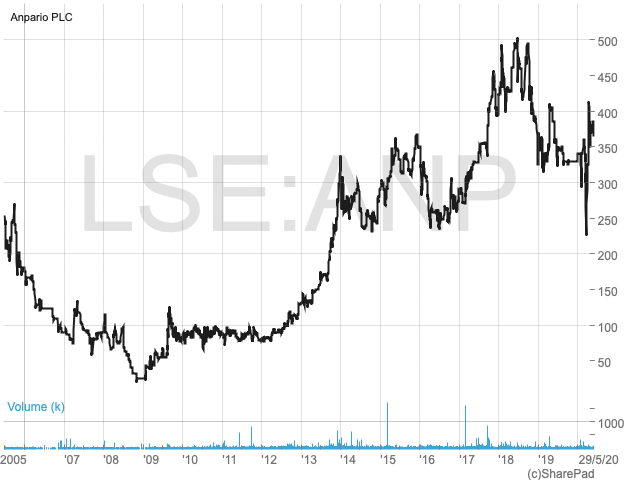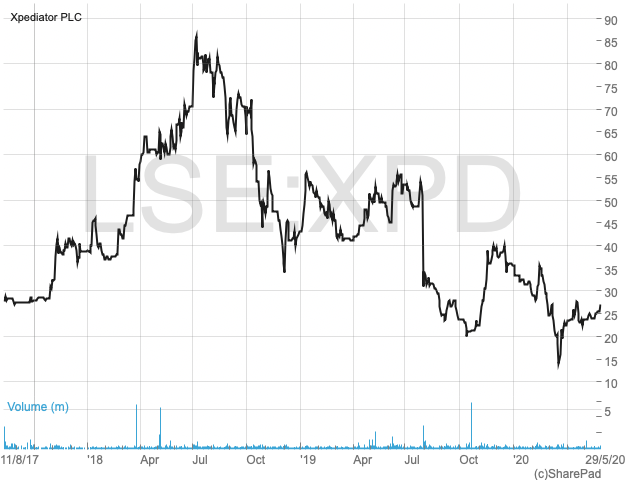Small-cap dividend stalwarts

Richard Gill, CFA, looks at three small-cap dividend stalwarts that are still paying and even increasing their distributions to shareholders in these uncertain times.
It’s not only falling share prices that have affected investors’ portfolios over the past two months. Many companies, determined to preserve cash during the global pandemic, have reduced, scrapped or even cancelled previously announced dividend payments, vastly reducing yields across the market.
According to research carried out by AJ Bell in mid-May, the total amount of dividend cuts and deferrals by UK companies has now hit £30bn. Even long-standing income distributors have reduced their payments, with Royal Dutch Shell making the first cut to its dividend for 75 years and Imperial Brands implementing a reduction for the first time since listing in 1996. Almost half of the FTSE 100’s constituents have now made such a move, with AJ Bell’s survey finding that the average investor has seen a 27% fall in dividend income.
It’s not all bad news, however − many companies have committed to maintaining their payments, including 26 FTSE 100 firms. While dividends may not be as much of a feature of small-cap companies, with growth the main focus in normal times, there is a clutch of smaller firms still paying and even increasing their distributions to shareholders. Here follow three of them.
ANPARIO
Having its origins in OFEX-markets-listed Kiotech, Anpario (LON:ANP) is a highly successful international producer and distributor of natural feed additives for animal health, nutrition and biosecurity. Its products help farmers to improve the health of their animals and thus to achieve higher yields, in turn helping to meet the ever-increasing global demand for food such as poultry, beef, fish and pig meat.
Key brands include Meriden – which supplies the flagship Orego-Stim additive and Optivite − feed additives that enable the greater absorption of nutrients. Topically, the firm’s Credence surface disinfectant can be used in infection-prevention measures against coronavirus.
Anpario’s product range is developed and manufactured at its facility in Worksop, Nottinghamshire, and then distributed to customers both in the UK and internationally, with a global sales and distribution network established in over 70 countries. Asia is the largest geographic segment at 38% of revenues, followed by the Americas and Europe. While the firm mainly uses local distributors overseas, it has a range of overseas subsidiaries, including in Brazil and China.
Beefing up
Anpario has an excellent track record, with revenues up from £10.95m to £29m from 2009 to 2019 and earnings per share up from 7p to 17.61p. Also, shareholders have enjoyed a rise in the dividend from 1.15p to 8p over 10 years.
Last year saw a solid performance in the face of a difficult year for global agriculture markets, which were challenged by extreme weather conditions, animal diseases and political uncertainty. But bolstered by a strong sales performance from Latin America (up 39%) and the Middle East and Africa (up 19%), revenues grew by a modest 3%. While gross margins were boosted by selling higher-value-added products, pre-tax profits slipped from £4.55m to £4.39m after a rise in admin expenses.
A further update from the company on 29 April revealed that a business-continuity plan implemented in March has enabled it to meet increased demand from customers, with operations experiencing little disruption from the coronavirus pandemic.
A “strong performance” was reported in the first quarter, after customers increased stock levels and as recent business-development initiatives came to fruition. Also, reflecting the sound operational set-up, the company gained new customers, who had experienced disruption from other suppliers. The cash balance was said to be £13.8m at 25 April, flat on the year end in December after a £1m share-buyback programme, with the company reaffirming its commitment to the previously announced final dividend of 5.5p, subject to shareholder approval at the AGM on 25 June.
Makin’ bacon
On the back of the April trading update, broker Peel Hunt raised its price target on Anpario from 310p to 360p. That doesn’t suggest much upside from the current price of 350p but I believe that a longer- term view can be taken here.
Aside from the company’s track record, it has a number of wider global trends going in its favour. According to the United Nations, the global population is set to reach 8.5bn by 2030, creating obvious challenges in feeding the world. One solution is to improve farming yields, an area in which Anpario specialises. Growth in ’westernised’ diets, which feature a higher proportion of animal protein, will also work in the company’s favour, as will farmers increasingly turning to natural additives due to concerns about artificial versions being harmful to human health. Anpario has grown successfully by acquisition in the past, and the current strong cash position puts it in a good place to make some additional earnings-enhancing deals.
Reflecting the company’s quality, Anpario shares currently trade on a multiple of 20 times historic earnings, or 16 times if we strip out the net cash. I don’t think that looks too pricey given the factors mentioned previously. Also, assuming that the dividend is passed at the upcoming AGM, the shares offer a modest, but useful in current times, yield of 2.3%.

S&U
This next company is one I have covered many times over the years, so I won’t go into detail about its operations, but will instead focus on its current prospects.
Founded in 1938, S&U (LON:SUS) is a finance provider which currently operates through two divisions. The core business is Grimsby-based motor-finance business Advantage, a leading supplier of specialist finance facilities that help customers buy used personal vehicles such as cars, vans, motorbikes and caravans. Advantage operates in the non-prime section of the market, with finance provided to consumers through hire-purchase contracts. The second, smaller division, launched in 2017, is Aspen Bridging, which provides property bridging loans.
Driving down
Following the rest of the market, shares in S&U fell sharply in February. But unlike many companies they have failed to make any kind of notable recovery. From February’s peak of £25, the shares now change hands for a little over £16, the lowest level for six years. Understandably, investors are concerned about rising levels of bad debts from the firm’s loan portfolio amidst the economic slump. But I think there is enough evidence in the recent full-year results to suggest an attractive buying opportunity now presents itself.
Pre-tax profits for the year to 31 January 2020 were up by 2% at £35.1m, the eleventh consecutive year of record profits. However, comments on current and expected future trading are more relevant here. In reaction to the lockdown situation, S&U has reduced risk by tightening underwriting criteria in both businesses, particularly with regard to the self-employed and those in the retail and catering sectors. Required loan-to-value ratios have also been tightened, maximum loans restricted and required repayment headroom revised.
At the time of the results on 8 April, the current performance was said to point towards to a period of minimal transactions in motor finance as brokers closed or furloughed staff and there was very little bridging-loan activity given a moribund residential-property market. These trends are expected to continue at least until 1 July. Meanwhile, the collections performance for March 2020 was said to be “just below normal” and increasing arrears are expected given falling consumer incomes and rising unemployment. Nevertheless, S&U remains open for business, with no staff having been furloughed. Due to the current uncertainty, the company is withdrawing future guidance but will update the market again on 9 June, the same day as its AGM.
This has been a challenging situation so far, albeit managed in a prudent manner, but some hope comes from the company’s attitude towards its dividend payment. Despite the challenges faced, management concluded that a final dividend of 50p per share would be recommended for 2020, taking the total for the year to 120p per share, a 2p increase on 2019. This is covered twice by earnings but subject to approval at the upcoming AGM. Supporting its decision, the company was keen to point out its long history of conservative management, the low gearing of 65.7% and significant funding and covenant headroom. The next few months are still expected to be cash-generative on current trends and in my view, cash generation could even improve, given the lower rate of new money being lent out.
Strong and undervalued
S&U has a reputation amongst investors for being a very well-run company, with management having always focused on sustainable expansion rather than taking on lower-quality new loans for growth’s sake. This strategy has delivered substantial returns over the years, with the shares up eightfold over the past two decades, even after the recent decline. On the income side, from 1988 the dividend was increased every year for 30 years and has since resumed its annual rise every year since 2010.
What the current full-year results will show is anyone’s guess at this stage. It is highly likely that the lower rates of new business, combined with increased defaults, will not result in a twelfth consecutive year of record profits. But taking a long-term view, if the company can get back to 2020 levels of profits and dividends, then at the current share price investors can buy into the business on a multiple of just 6.7 times earnings and a 7.4% yield. Chairman, Anthony Coombs, sees the attraction, recently buying 3,090 shares for his SIPP.

XPEDIATOR
One way a company can both preserve cash on the balance sheet as well as reward shareholders is by way of a scrip dividend, where investors are issued with additional shares in a company in place of a cash payment. The shares can then simply be sold on the market for a cash boost or held for capital growth.
Recently announcing a scrip dividend is Xpediator (LON:XPD), a provider of freight-management services across the UK and central and eastern Europe. Founded in 1988 by chief executive Stephen Blyth, the company has an international network of offices that provide road, sea and air-freight services, together with logistics and over 90,000 sqm of warehousing in the UK and Romania.
The business offers integrated freight management within the supply-chain logistics and fulfilment sector, through the three main areas of freight forwarding, logistics and warehousing and transport services. Xpediator is unique in that it operates an asset-light business model – it does not own any warehousing facilities or a large fleet of trucks, typically acting as a broker to clients, sourcing capacity from the market. In the current environment that means it doesn’t have to bear large costs associated with idle drivers or vehicles.
Trucking on
Xpediator listed on AIM in August 2017, raising £5m to spend on acquisitions and organic growth plans. Four acquisitions have been completed since then, helping revenues grow from £116.3m in 2017 to £213.2m in 2019, with pre-tax profits up from £2.4m to £5.2m.
Last year was actually a mixed one for the company despite the increase in revenues. July saw the issuing of a warning that profits would be materially below market expectations due to a range of factors, including the loss of a large customer, higher labour costs and lower e-commerce revenues. When the numbers were released in mid-April, however, they were ahead of the lowered expectations.
Highlights of the year included core division freight forwarding growing revenues by 16.6% to £159.6m, with the Baltics and Balkans key areas of strength despite strong prior-year comparators. Logistics revenues meanwhile increased by 32.2% to £47.5m, with a lease signed post year end for a new purpose-built, 20,000 sqm facility in the Port of Southampton. The facility is expected to become operational in February 2021.
Due to the pandemic issues, Xpediator announced at the time of the results that a scrip dividend will be paid. The scrip will amount to 1.05p per share, with the payment having already been approved at the AGM, and an ex-dividend date of 11 June. It is expected that the 2020 interim dividend will return to being paid in cash.
A further update at the end of May revealed that trading amidst the global pandemic had been resilient, with activity levels slightly lower but with strong demand from some sectors. The impact on margins has been less affected as a result of significant cost reductions but as yet the company believes it is too early to provide definitive guidance for the full year. Nevertheless, the board believes the business is performing well in extraordinary circumstances, highlighting its asset-light base and spread of activity across multiple sectors and geographies. The focus on the central and eastern Europe markets, which have suffered less from the pandemic, has been a key area of strength.
Highly ‘pallet-able’ valuation
At the current price of 27p, the markets are valuing the business at just £36.7m, not much more than the net asset value of £29m as at 31 December last year. Net cash as at that date amounted to £7m, providing plenty of working capital, as well as funds for any smaller deals to be made. On an earnings basis, the shares are on a multiple of just under 10 times last year’s adjusted earnings, providing an illustration of what investors are paying despite the uncertainty over the current year.
Finally, the upcoming scrip dividend equates to a decent yield of 3.9%, assuming that recipients want to cash in. But those with a longer-term view might want to hold on to the shares. Xpediator is a highly ambitious company, having a vision over the next five years to become a leading, international freight-management and logistics provider, generating revenues in excess of £1bn. That implies the aim is to grow the business fivefold, with the strategy focused on organic growth, along with further acquisitions.

Comments (0)